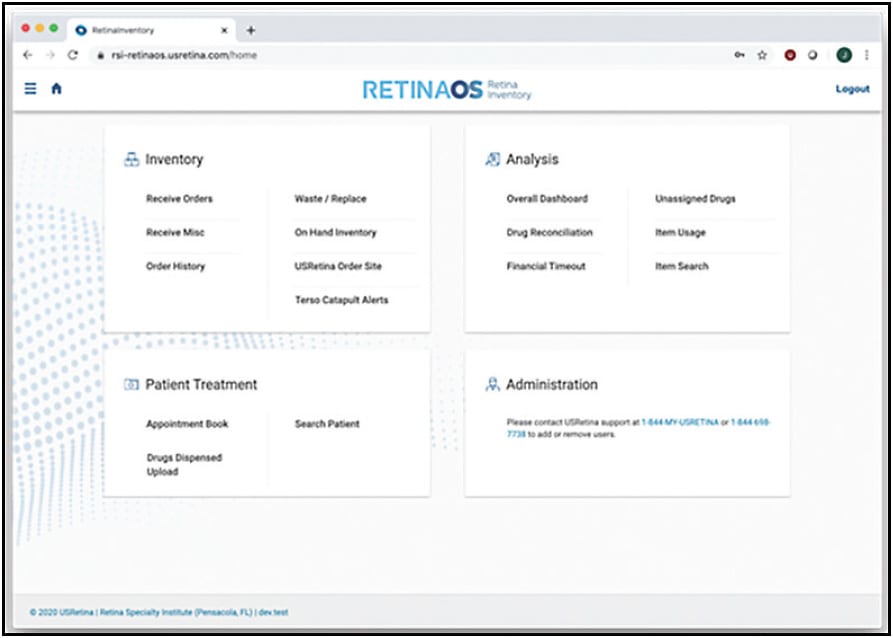As a retina specialist and managing member at Retina Specialty Institute in Pensacola, Florida, Sunil Gupta, MD, saw a need for a more robust inventory management system dedicated to retina practices. Consequently, he worked with USRetina, a provider of technology and services specific to retina practices, to create a prototype for a new system called RetinaOS.
“Because retina clinics are busy and use expensive biologics, the new system needed to quickly, accurately, and efficiently highlight the complete life cycle of each drug vial,” Dr. Gupta says.
Jacob Alcauskas, vice president of product at USRetina, says its member practices were underserved by current offerings, which either struggled to provide retina-specific features due to serving multiple specialties or locked practices into a single distributor.
The RetinaOS platform brings a new level of business flexibility and adaptability to retina practices. It streamlines drug purchasing, improves operations management, optimizes revenue cycle management, and helps physicians navigate regulatory changes while they build bottom-line revenue, Alcauskas says.
BENEFITS TO RETINA SPECIALISTS
RetinaOS features a distributor-agnostic platform built specifically for retina care. “This gives retina practices complete control,” Alcauskas says. “They can shop around for better pricing or use multiple distributors when drug shortages occur.”
Dr. Gupta notes that pharmaceutical manufacturers typically use multiple distributors. These distributors’ inventory systems are designed to accommodate multiple specialties, many of which are hospital based. Other new entrants address a diverse group of practices, including veterinarians, and may not be focused on the intricacies of a retina practice.
“My goal was to work with USRetina and other retina physicians to design a unique solution focused only on the needs of retina and ophthalmology practices,” Dr. Gupta says. “Previous systems have gaps, such as a lack of interoperability required to create a fully closed loop system for documentation, billing, and practice accounting systems, because different vendors typically provide each of these technologies. Optimization of processes to reduce human errors requires obtaining data from electronic health records, scheduling/billing software, inventory systems, and accounting systems to identify mistakes that need correction. Additionally, having a report dedicated to only reporting errors enables technicians to efficiently reconcile any differences.”

WHAT IT CAN DO
RetinaOS is integrated with USRetina’s RetinaPurchasing, which is a purchasing portal that provides broad access to retina-specific pharmaceuticals. This integration enables retina practices to streamline their drug receivables by pre-loading purchase orders into RetinaOS. RetinaOS also integrates invoices for orders placed through RetinaPurchasing, giving retina practices powerful tools to manage their drug spend and usage, Alcauskas says.
The RetinaOS platform also includes RetinaInventory, an inventory management and practice data consolidation solution. By integrating with a practice’s appointment book, RetinaOS can give retina practices a look at their upcoming drug usage and current inventory levels, allowing retina practices to better manage cash flow and stock levels.
RetinaOS is built for a retina practice’s clinical workflow, supporting a high volume of patients, Alcauskas says. Designed to not only track inventory but also to support drug administration, RetinaOS streamlines clinical operations.
A practice’s analytics are shown on a single dashboard, providing a snapshot of its drug inventory landscape. The system sends alerts for expired drugs, 28-day injection rules, and specialty pharmacy/sample allocation to ensure accurate clean claims.
The RetinaOS cloud-based platform brings together disparate point solutions into one operating system for a retina practice. “It’s easy to use and reduces training time or the lost time value of staff turnover in learning new platforms,” Alcauskas says.
Furthermore, RetinaOS allows retina practices to reconcile their administered drugs against their encounters and claims to ensure that all administered drugs have correctly been billed for. “They can verify that the proper drug and dosage was administered, and that it was done in the correct eye,” Alcauskas says. RetinaOS also ensures that practices receive every vial ordered, that they bill for every administered drug, and that they collect every payment.
“USRetina’s strong background in health care regulatory compliance ensures that both the platform and network are supported with the latest and greatest regulatory updates,” Alcauskas says. “Practices are up-to-date on new policy developments at the federal level that affect drug purchasing, billing, and dispensing.”
After one week of using RetinaOS, Dr. Gupta’s practice achieved 98% accuracy in the RetinaInventory system. Soon after that, his practice hit 99.7% accuracy, and has only had to correct 3 encounters per 1,000 injections to quickly attain 100% accuracy before claims submission.
LOOKING TO THE FUTURE
To prosper in the future, Dr. Gupta says retina practices will need to become much more sophisticated in both clinical and financial operations. “This will require minimization of overhead, while making sure that a retina practice’s largest financial risks are mitigated,” he says. “Our practices have not been tooled or trained to take on the operational side of multimillion-dollar transactions.”
By having the interoperability of technology systems that run retina practices in a system like RetinaOS, Dr. Gupta says efficient patient care delivery is achievable. “If we can optimize our financial margins in a market that has ever-increasing overhead costs while decreasing reimbursements, independent practices will be sustainable,” he says. As a result of implementing RetinaOS and now having many checks and balances in place, Dr. Gupta says he can begin to focus solely on patient care and accommodate more patients.
Along these lines, Alcauskas says that RetinaOS relieves clinical staff of routine tasks so that they can focus on patients. “Clinics that use RetinaOS for purchasing, inventory, revenue cycle management, and reporting have eased the business burden on doctors and administrators and can reallocate critical physician time on patients and their clinical needs,” he says. RP








